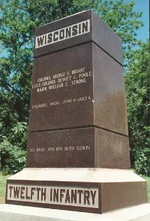Service
The 12th Wisconsin was raised at Madison, Wisconsin, and mustered into Federal service October 18, 1861. It departed Madison for Fort Leavenworth, Kansas, on January 11, 1862, arriving there on February 16. Marched from Fort Leavenworth To Fort Scott, Kansas March 1–7. Duty there till March 27. Ordered to Lawrence, Kansas March 27. Ordered to Fort Riley April 20, then to Fort Leavenworth May 27. They were attached to the Department of Kansas to June, 1862. [1] the 12th moved to various locations from March 1, 1862, to April 18, 1863. [2]
The Vicksburg Campaign
The 12th was ordered to the Siege of Vicksburg May 11, arriving there on May 22, and staying at the siege until July 4 when it was finished. At Vicksburg the 12th was part of the Third Brigade of the Fourth Division of the Sixteenth Army Corps. [3] Immediately after, the 12th marched towards Jackson, Mississippi, and participated in the siege of the city. Ordered back to Vicksburg until August 15, when it went on an expedition to Tupelo September 1–8, capturing Fort Beauregard on September 4. [2] It joined General Sherman's army in the Meridian Campaign, and then returned to Vicksburg until April, when the regiment left for Cairo, Illinois. After that, they moved to Clifton, Tennessee, then to Acworth, Georgia. [2]
The Atlanta Campaign and follow ups
The regiment assaulted Kenesaw Mountain on June 27, 1864. After that, they were engaged in several battles around Chattahoochee River from July 2 through 17. They sieged Atlanta July 22 through August 25. After that, they participated in the Battle of Jonesborough (August 31 – September 1). [2]
On November 15, "Sherman's March to the Sea" commenced, ending on December 10, at Savannah, Georgia. On January 1, Sherman's army began the Carolinas campaign. They captured Pocotaligo on January 14, were engaged at Salkehatchie Swamp February 2–5 and at Binnaker's Swamp on the 9th. They then captured Orangeburg on February 11–12, and Columbia on February 16–17. They participated in the Battle of Bentonville on March 19–21. They occupied Goldsboro on March 24, then Raleigh on April 14. On April 29, they started marching towards Washington, D.C., and reached it on May 19. [2]
The regiment was mustered out on July 20, 1865, at Louisville, Kentucky. [4]
This page is based on this
Wikipedia article Text is available under the
CC BY-SA 4.0 license; additional terms may apply.
Images, videos and audio are available under their respective licenses.

